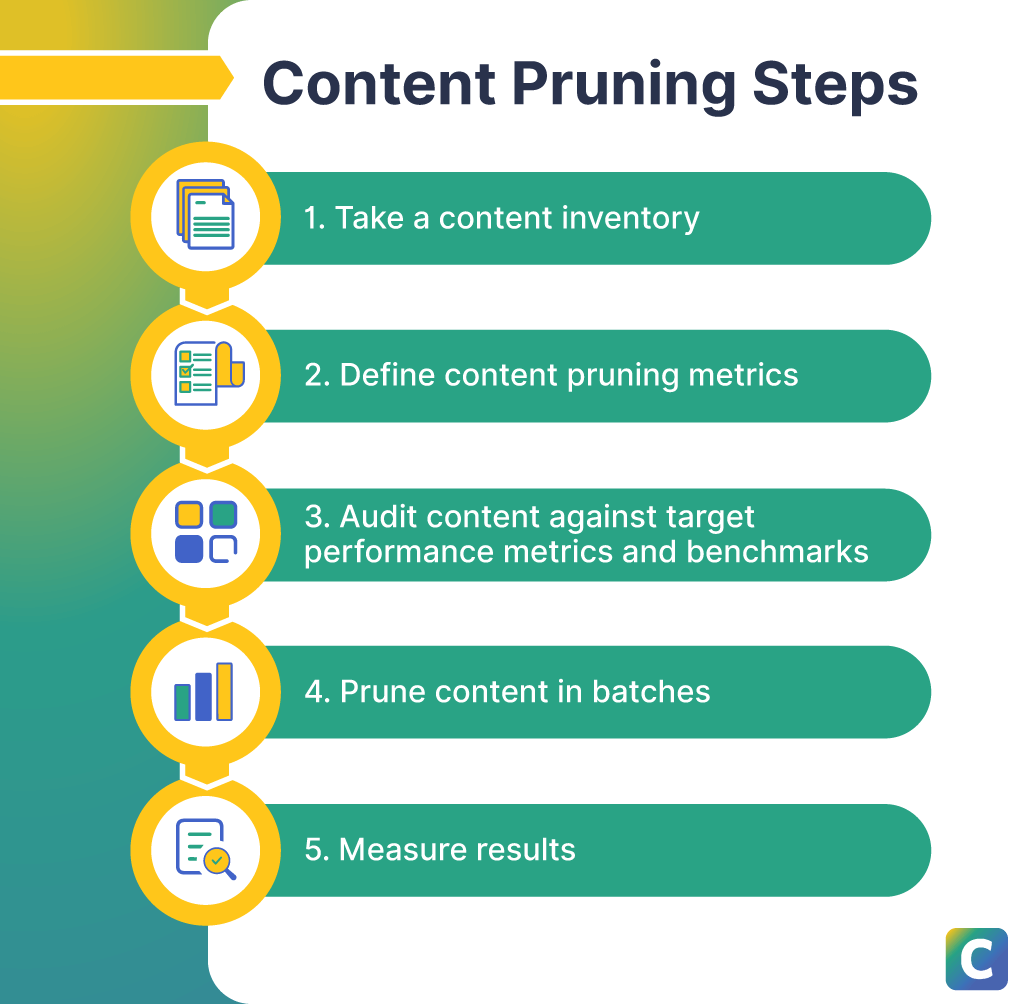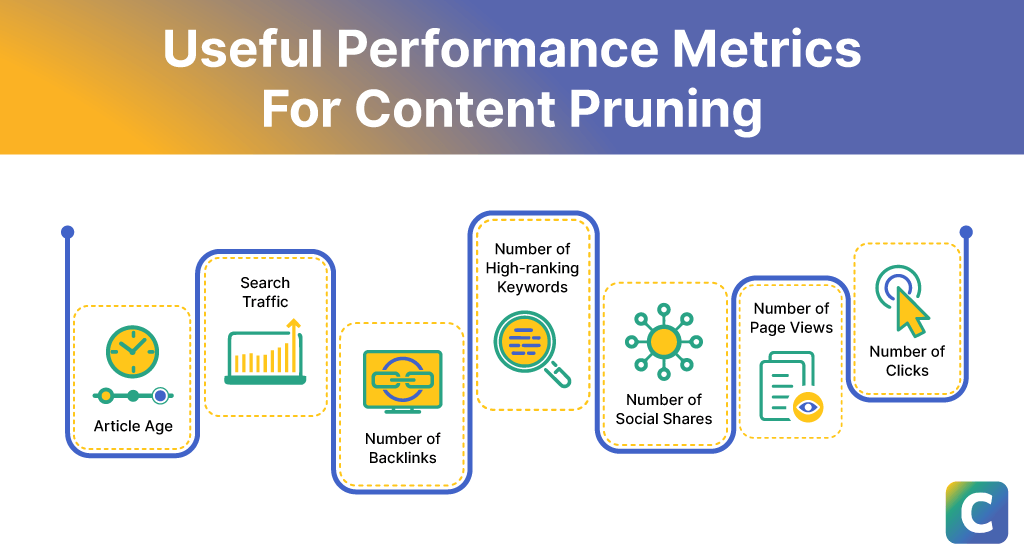What Is Content Pruning and Why It Matters for SEO
Topic: Content Marketing
Published:
Written by: Bernard Huang
TL;DR: What Is Content Pruning?
Content pruning is the process of assessing and refining your website’s content to remove low-quality content, outdated, or duplicate pieces.
This strategic cleanup involves reviewing web pages or old content on your blog regularly, deciding whether to update, consolidate, or delete them.
The ultimate goal is to enhance the overall quality of your website, improve user experience, and boost search engine optimization (SEO) performance by ensuring that only valuable and relevant content remains on your site.
This process is essential in content marketing to maintain a strong online presence.
In this Clearscope webinar, we tackle what content pruning is and why you need to do it.
Quick Overview: Content Pruning Benefits
The benefits of content pruning are plenty.
It should be an important part of your overall strategy to improve search engine rankings, enhance user experience, and boost conversions and engagement across your site.
By removing underperforming content and focusing on high-quality, relevant pieces, your site becomes more efficient and effective for both users and search engine bots.
This, in turn, helps increase organic search traffic and ensures that your website remains a go-to resource for your target audience.
Why Content Pruning Matters for Your Website’s SEO Performance
Here’s why it’s important to regularly prune your content inventory:
It impacts your search engine rankings
It can help enhance link equity
It reduces keyword cannibalization across your site
It improves user experience
It can lower bounce rate
It can boost conversions
1. It impacts search engine rankings
Here’s how content pruning affects organic traffic and SERPs: It’s crucial for maintaining and improving your website's search engine rankings.
By removing outdated content, thin content, or low-quality pages, you can positively impact your site’s visibility on search engine results pages (SERPs).
High-quality SEO content that aligns with user search intent is more likely to rank well, thereby driving more organic search traffic.
2. It can enhance link equity
Pruning also helps in redistributing link equity across your site.
When low-quality pages are removed or consolidated, the value from backlinks is concentrated on the remaining high-quality pages, thus improving their ranking potential.
3. It reduces keyword cannibalization
Keyword cannibalization occurs when multiple pages on your site compete for the same keywords, leading to a dilution of ranking potential.
Content pruning can help resolve this issue by consolidating similar topics into comprehensive, singular pages, thereby strengthening their authority and relevance.
4. It improves user experience
When you remove underperforming pages, it allows pages that have relevant Information and higher overall quality get more attention.
A website filled with outdated or irrelevant content can frustrate users and increase bounce rates.
Content pruning helps maintain the relevance and overall quality of your site’s content, ensuring that users find valuable information that meets their needs.
This leads to a better user experience and encourages visitors to stay longer on your site.
5. It can lower bounce rate
High-quality content that is relevant and well-organized can lower bounce rates.
When users find good content—interesting, valuable content that gives them what they are looking for—they are more likely to engage, navigate through your site, and potentially convert into customers or loyal followers.
6. It can boost conversions and engagement
Effective content pruning should align your website’s content with the search intent of your target audience.
By focusing on what your audience is searching for and providing high-quality answers, and removing older content that no longer serves your audience, you may be able to increase engagement and conversion rates.
This is crucial for removing older, outdated, or underperforming landing pages, which need to be sharply optimized to match user expectations and encourage actions.
Your content quality can be a significant factor in driving your conversions. Engaging, informative, and well-structured content not only attracts visitors, but also builds trust and persuades them to take desired actions, like:
Making a purchase
Signing up for a newsletter
Downloading a resource
High bounce rates can often be attributed to underperforming content that doesn't align with user intent.

Basic steps for content pruning.
How Does Content Pruning Work
Let’s look at what should be a part of your content pruning process.
Content Inventory and Content Audit
The first step in the content pruning process is conducting a thorough content inventory and audit. This involves cataloging all existing content, evaluating its performance, and assessing its relevance and quality.
Tools like Clearscope, Google Analytics, Google Search Console, Ahrefs, or SEMrush can be invaluable in this process, providing:
Insights into metrics like page views
Overall impressions and engagements
Bounce rates
Keyword rankings
Identifying Low-Quality, Outdated, and Duplicate Content
Analytics tools can help your identify low traffic pages that may need improvement or removal.
And once you have a complete overview of your content, the next step is identifying pieces that are low-quality, outdated, or duplicate.
These are prime candidates for pruning.
Consider factors like the content’s age, relevance, performance metrics, and how well it aligns with current SEO best practices.
Using meta descriptions and headings effectively can improve SEO content by highlighting important information and increasing click-through rates.
Strategies for Pruning Content
Consolidating and Repurposing Content
One strategy for content pruning is consolidating similar content into a single, comprehensive page.
This not only reduces the number of pages competing for the same keywords but also creates a stronger, more authoritative resource.
Repurposing content into different formats that better meet the user’s target search intent, such as turning a blog post into a video or infographic, can also extend its usefulness and reach.
Deciding When to Delete Content or Noindex Pages
Sometimes, the best course of action is to delete content altogether, especially if it’s outdated or no longer aligns with your website’s SEO strategy.
Alternatively, using the noindex tag can prevent certain pages from being indexed by search engines without removing them from your site.
Managing Internal and External Links
As you prune content, it’s important to manage both internal and external links.
Ensure that any deleted or consolidated content has proper redirects in place to avoid broken links and maintain a good user experience.
Update internal links to point to the most relevant and high-quality pages.
A traditional SEO tool like ScreamingFrog can help you do this, or Clearscope can also provide clear, easy-to-understand linking opportunities throughout your content inventory.
How to Monitor and Measure SEO Performance Before and After Content Pruning
To measure the impact of content pruning, use tools like Google Analytics and Google Search Console to track changes in key metrics.
Look for improvements in organic traffic, bounce rate, and conversion rates. These tools can also help monitor how Google’s crawlers interact with your site.
A lower bounce rate and increased page views typically indicate that users are finding your content more engaging and relevant.

Useful performance metrics for content pruning.
Best Practices for Content Pruning
Set Up a Content Calendar for Regular Reviews: Establish a regular schedule for content reviews and pruning. A content calendar helps ensure that you continuously assess and update your content, keeping it fresh and relevant.
Understand and Leverage Your Crawl Budget: Effectively managing your crawl budget is essential, especially for large websites. Prioritize high-quality, updated content to ensure that search engine bots spend their limited crawl time on the most valuable parts of your site.
Prioritize High-Quality Content and Effective Content: Focus on creating and maintaining high-quality, effective content. Prioritize pieces that provide value to your audience and align with your SEO strategy.
Incorporate User Feedback and Social Media Insights: Use feedback from users and insights from social media to identify areas for improvement. This can help you understand what your audience values and guide your content pruning decisions.
Use SEO Tools for Benchmarking and Tracking Improvements: Leverage SEO tools to benchmark your site’s performance before and after pruning. Track improvements in search rankings, organic traffic, and other key metrics to evaluate the effectiveness of your content pruning strategy.
Additional Tips for Content Pruning
Balance SEO Strategy and Content Strategy
Content pruning should align with both your SEO and content strategies. Ensure that your efforts to clean up and optimize content also support your broader marketing and business goals.
Know the Role of Algorithm Updates in Content Pruning
Keep an eye on algorithm updates from search engines like Google. These updates can impact how content is ranked and should inform your content pruning and SEO strategies.
Align Pruning Efforts With Marketing Strategy
Content pruning should not only focus on SEO benefits but also align with your overall marketing strategy. Ensure that the content you keep supports your brand message and business objectives.
Plan for New Content and Maintaining Content Performance
Pruning content is an ongoing process. Plan for the creation of new, high-quality content while maintaining the performance of existing pieces. This balance ensures that your site remains relevant and authoritative.
Handle Dead Weight: Outdated Information and Low-Performing Content
Address outdated information and low-performing content as part of your pruning efforts. Removing or updating this “dead weight” helps improve your site’s overall quality and user experience.
The Future of Content Pruning: Trends and Predictions
As search algorithms and user expectations evolve, so too will content pruning practices. Stay informed about industry trends and best practices to keep your site optimized and competitive.
FAQ: Addressing Common Concerns and Misconceptions
Q: When Do You Unpublish a Piece of Content From Your Content Library?
Unpublish content when it is outdated, irrelevant, or no longer aligns with your site’s goals. However, consider whether the content can be updated or repurposed before deciding to remove it entirely.
Additional Resources and Citations
What Is Content Decay and Why It Matters for SEO
Discover what content decay is and why it matters for SEO. Understand its impact and learn best practices to combat it for sustained website health and performance.
Read moreHow to Create a Content Inventory & Perform a Content Audit
Our post explains how to perform a content inventory, audit your existing website content, and maintain an SEO-optimized site — in four simple steps.
Read moreHow to Add Information Gain to Your Content: 3-Phase Plan
In this straightforward, 3-part plan, you'll find out how incorporate information gain into your existing SEO content and test outcomes.
Read more